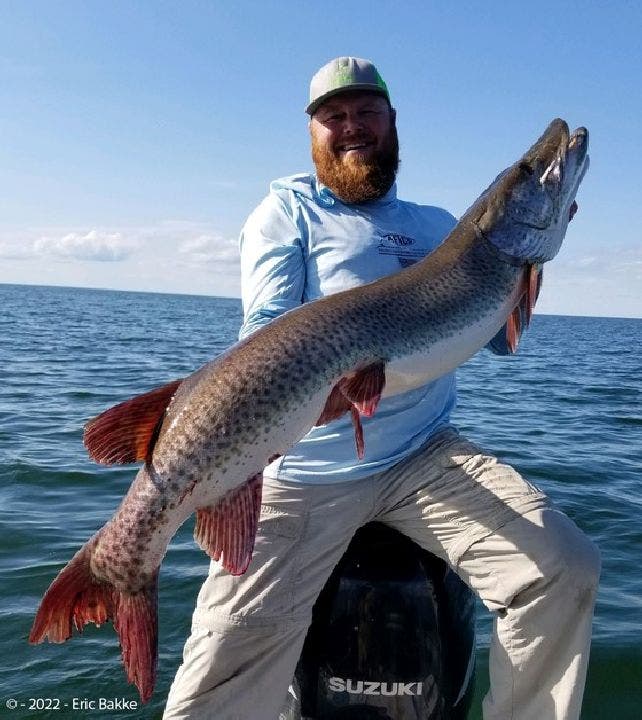What Color is Your Largemouth Bass? Uncover the Mystery!
Largemouth bass are fascinating creatures with unique colors. Their color can vary based on many factors.
Largemouth bass usually have greenish bodies with dark, horizontal stripes. Their color can change due to their environment, diet, and health. Understanding what affects their color can be interesting for anglers and nature lovers alike. In this blog, we will explore the different colors of largemouth bass and the reasons behind these changes.
Discovering this can help you understand these fish better and even improve your fishing skills. Dive into the world of largemouth bass colors with us.

Credit: www.sigmanustore.com
Introduction To Largemouth Bass Colors
Understanding the colors of largemouth bass can be fascinating. These fish are known for their distinct appearances. Their colors can vary, making them a unique catch for anglers. In this section, we’ll explore common color variations and the importance of color in largemouth bass.
Common Color Variations
Largemouth bass often display a range of colors. Typically, they have a greenish hue. This color helps them blend into their surroundings. Their bellies are usually white or light yellow. Some bass may have a darker back. The sides of the fish may show a pattern of dark blotches. This pattern can look like a horizontal stripe.
In clear water, bass colors tend to be more vibrant. They might appear more green and shiny. In murky water, their colors may be duller. Factors like diet and habitat can also influence their color. Young bass usually have less distinct patterns. As they grow, their colors and markings become more defined.
Importance Of Color
The color of largemouth bass plays a crucial role. It helps them hide from predators. It also aids in hunting prey. A well-camouflaged bass is more successful in catching food. Anglers often use color to identify the health of the fish. Bright, vibrant colors can indicate a healthy bass. Dull or faded colors might suggest stress or poor health.
Color can also provide insights into the fish’s environment. Fish from clear waters often look different from those in muddy waters. By observing color, anglers can learn more about the habitat. This knowledge can be helpful for fishing strategies. Understanding color variations can make fishing more enjoyable and successful.
Factors Affecting Bass Color
Largemouth bass can display a range of colors. The color of your bass can be influenced by several factors. Understanding these factors can help anglers know more about their catch.
Water Quality
Water quality plays a key role in the color of largemouth bass. Clear water usually results in brighter, more vivid colors. Muddy or stained water can make bass appear darker.
- Clear Water: Bass in clear water often have greenish hues.
- Muddy Water: Bass in muddy water may look brown or dark.
Diet And Nutrition
The diet of a bass can also affect its color. A varied diet rich in nutrients can lead to healthier and more vibrant colors.
For example:
| Diet Type | Potential Color |
|---|---|
| Crayfish | Reddish tones |
| Smaller Fish | Silvery or greenish tones |
Balanced nutrition is essential for maintaining the natural color of bass.
Seasonal Color Changes
Largemouth bass are fascinating creatures, especially when it comes to their color changes. These color changes can be influenced by various factors, including the season. Understanding these seasonal color variations can help anglers and enthusiasts better appreciate these fish.
Spring And Summer
In spring, largemouth bass often display vibrant colors. Their scales can show a deep green hue. This green is contrasted by dark blotches along their sides. These colors help them blend with the lush underwater vegetation. During summer, the colors can become even more pronounced. The bass can appear almost emerald green. Bright sunlight and warmer water temperatures enhance their vivid appearance.
Fall And Winter
As temperatures drop in fall, largemouth bass undergo noticeable color changes. Their vibrant green hues begin to fade. They take on a more subdued olive tone. This helps them blend with the decaying vegetation. In winter, the color changes become even more drastic. The bass can appear almost grayish. This helps them stay hidden in the murkier, colder waters. The subtle color shifts are crucial for their survival during these harsher months.
Habitat And Environment
The color of a largemouth bass often reflects its habitat and environment. These factors influence their appearance significantly. The surroundings, water quality, and food sources all play roles in their coloration.
Lake Vs. River Bass
Largemouth bass in lakes usually appear darker. The calm waters and deeper habitats provide more cover. This results in a greenish or brownish hue. They need to blend in with aquatic plants and submerged structures.
In rivers, largemouth bass show a lighter color. The flowing water and varied terrain affect their shade. They might appear more silvery due to the need for quick adjustments. The constant movement and changing light conditions contribute to this difference.
Impact Of Vegetation
Vegetation significantly impacts the color of largemouth bass. Areas with dense plant life offer more cover. This leads to darker, greener bass. They need to hide from predators and catch prey effectively.
In contrast, bass in areas with sparse vegetation appear lighter. Less cover means less need for dark coloration. These bass need to adapt to open water conditions. Their lighter color helps them avoid predators in clearer waters.
Genetics And Coloration
The coloration of a largemouth bass is a fascinating subject. Understanding its genetics gives us insights into why these fish look the way they do. Coloration in largemouth bass is influenced by several factors. Genetics play a vital role in determining their appearance. Let’s explore the genetic factors and color variations that make each largemouth bass unique.
Inherited Traits
Largemouth bass inherit their colors from their parents. Genes control the pigmentation in their scales. These genes determine the intensity and pattern of colors. Some bass may be darker or lighter based on their genetic makeup. The environment can also influence their coloration. Yet, genetics set the foundation for their appearance.
Color Morphs
Largemouth bass exhibit various color morphs. These are unique color patterns that occur in nature. Common color morphs include green, brown, and sometimes even black. Each color morph has its own genetic background. Some bass may have a mix of these colors. This creates a unique and beautiful pattern on each fish. These variations make the largemouth bass a visually striking species.

Credit: www.russells.com
Health And Color Indicators
The color of a largemouth bass can tell a lot about its health. Bright, vibrant colors usually indicate a healthy bass, while dull, faded colors can be a sign of disease or poor conditions. Understanding these indicators can help in monitoring the well-being of your fish.
Signs Of A Healthy Bass
A healthy largemouth bass will typically exhibit the following color characteristics:
- Bright green or olive hues: These colors are a sign of good health.
- Clear and distinct markings: Healthy bass have well-defined patterns on their body.
- Shiny scales: The scales should look bright and reflective.
In addition to color, observe the following signs of health:
- Active behavior: A healthy bass will be lively and swim actively.
- Good appetite: Healthy bass will have a strong appetite and eat regularly.
Diseases Affecting Color
Several diseases can cause color changes in largemouth bass. Here are some common ones:
| Disease | Color Changes | Other Symptoms |
|---|---|---|
| Ich | White spots | Scratching against objects |
| Fin Rot | Fading and fraying | Damaged fins |
| Fungal Infections | White or gray patches | Sluggish behavior |
Ensuring proper water quality, diet, and habitat can prevent these diseases. Regularly check your bass for any signs of illness and take action quickly if you notice any changes in their color or behavior.
Fishing Techniques And Color Perception
Understanding color perception can improve your fishing techniques. Fish see colors differently than humans. This can influence your choice of lures and bait. It also impacts their visibility in different waters. Let’s explore how you can use this knowledge to catch more largemouth bass.
Lures And Bait Selection
Choosing the right lure color can make a big difference. Bass have good color vision. They see red and green well. Blue and purple are less visible to them. In clear water, bright colors work best. In murky water, darker colors perform better. Match your lure color to the water conditions. This increases your chances of a bite.
Visibility In Different Waters
Water clarity affects how fish see your lure. In clear water, light penetrates deeper. Bright and natural colors are more visible. In stained or muddy water, light doesn’t travel as far. Darker lures stand out better. Adjust your color choices based on water conditions. This will help you catch more bass.

Credit: www.outdoorlife.com
Conservation And Color Preservation
Conservation and color preservation of largemouth bass are crucial. These efforts ensure the fish remain vibrant and healthy. Conserving habitats and maintaining water quality play vital roles. They help protect these iconic fish and their stunning colors.
Protecting Habitats
Protecting habitats is essential for largemouth bass. These fish need clean, well-maintained environments. Natural habitats provide shelter and food. They support the growth and survival of bass. Healthy habitats help preserve the fish’s natural color. This makes them more attractive to anglers and nature enthusiasts.
Vegetation around water bodies acts as a natural filter. It helps keep the water clean and clear. This promotes a healthier habitat for bass. Planting native plants along shorelines can support habitat protection. This helps reduce erosion and sedimentation. Both of which can harm water quality and fish health.
Maintaining Water Quality
Maintaining water quality is critical for largemouth bass. Clean water supports their health and coloration. Pollutants and toxins can harm these fish. They can cause stress and dull their vibrant colors. Reducing runoff from agricultural and urban areas is vital. It helps keep water bodies clean and safe.
Regular monitoring of water quality is necessary. It helps identify potential issues early. Addressing problems promptly can prevent long-term damage. Using eco-friendly products can also help. They reduce the amount of harmful chemicals entering water bodies.
Educating local communities about water quality is important. People need to understand their impact on the environment. Simple steps like proper disposal of waste can make a big difference. Cleaner water means healthier, more colorful largemouth bass.
Conclusion And Summary
Understanding the color variations of largemouth bass can enhance your fishing experience. The color of a largemouth bass changes with its environment, diet, and health. Recognizing these color changes can help you identify the best fishing spots and times.
Key Takeaways
- Color Variability: Largemouth bass color ranges from green to brown. This depends on habitat and diet.
- Environmental Influence: Clear water bass tend to be lighter. Murky water bass appear darker.
- Health Indicators: Healthy bass display vibrant colors. Dull colors may indicate poor health.
- Diet Impact: A diet rich in certain foods can affect a bass’s color.
Future Research Directions
Further research can explore how water quality affects bass coloration. Scientists could study the impact of seasonal changes on bass color. Another area of interest is the genetic factors influencing bass color. Understanding these aspects can provide deeper insights into largemouth bass behavior and health.
Possible Research Areas:
- Impact of water pollution on bass color.
- Seasonal changes and their effect on bass coloration.
- Genetic studies on largemouth bass color variations.
Frequently Asked Questions
What Color Is A Largemouth Bass?
A largemouth bass is typically greenish with dark horizontal stripes. The belly is white or light-colored.
Do Largemouth Bass Change Color?
Yes, largemouth bass can change color based on their environment, stress levels, and health.
Why Does My Largemouth Bass Look Pale?
A pale largemouth bass might be stressed, sick, or in a less colorful environment.
How To Identify A Largemouth Bass?
Identify a largemouth bass by its greenish color, dark stripes, and large mouth extending past its eye.
Conclusion
Exploring the colors of largemouth bass can be fascinating. These fish change hues depending on their environment. Clear water makes them light green. Murky water gives them a darker shade. Knowing this helps you spot them better. The next time you go fishing, pay attention to their colors.
It tells a lot about their habitat. Happy fishing and enjoy observing these beautiful creatures!


